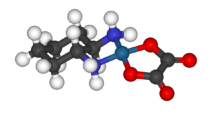Oxaliplatin
 | |
 | |
| Clinical data | |
|---|---|
| Routes of administration | Intravenous |
| ATC code | |
| Pharmacokinetic data | |
| Bioavailability | Complete |
| Elimination half-life | ~10 - 25 minutes [1] |
| Excretion | Renal |
| Identifiers | |
| |
| CAS Number | |
| PubChem CID | |
| DrugBank | |
| E number | {{#property:P628}} |
| ECHA InfoCard | {{#property:P2566}}Lua error in Module:EditAtWikidata at line 36: attempt to index field 'wikibase' (a nil value). |
| Chemical and physical data | |
| Formula | C8H14N2O4Pt |
| Molar mass | 395.27 g/mol |
|
WikiDoc Resources for Oxaliplatin |
|
Articles |
|---|
|
Most recent articles on Oxaliplatin Most cited articles on Oxaliplatin |
|
Media |
|
Powerpoint slides on Oxaliplatin |
|
Evidence Based Medicine |
|
Clinical Trials |
|
Ongoing Trials on Oxaliplatin at Clinical Trials.gov Clinical Trials on Oxaliplatin at Google
|
|
Guidelines / Policies / Govt |
|
US National Guidelines Clearinghouse on Oxaliplatin
|
|
Books |
|
News |
|
Commentary |
|
Definitions |
|
Patient Resources / Community |
|
Patient resources on Oxaliplatin Discussion groups on Oxaliplatin Patient Handouts on Oxaliplatin Directions to Hospitals Treating Oxaliplatin Risk calculators and risk factors for Oxaliplatin
|
|
Healthcare Provider Resources |
|
Causes & Risk Factors for Oxaliplatin |
|
Continuing Medical Education (CME) |
|
International |
|
|
|
Business |
|
Experimental / Informatics |
Please Take Over This Page and Apply to be Editor-In-Chief for this topic: There can be one or more than one Editor-In-Chief. You may also apply to be an Associate Editor-In-Chief of one of the subtopics below. Please mail us [1] to indicate your interest in serving either as an Editor-In-Chief of the entire topic or as an Associate Editor-In-Chief for a subtopic. Please be sure to attach your CV and or biographical sketch.
Overview
Oxaliplatin is a platinum-based chemotherapy drug in the same family as cisplatin and carboplatin. It is typically administered in combination with fluorouracil and leucovorin in a combination known as FOLFOX for the treatment of colorectal cancer. Compared to cisplatin the two amine groups are replaced by cyclohexyldiamine for improved antitumour activity. The chlorine ligands are replaced by the oxalato bidentate derived from oxalic acid in order to improve water solubility.
Oxaliplatin is marketed by Sanofi-Aventis under the trademark Eloxatin®.
Mechanism of action and efficacy
The exact mechanism of action of oxaliplatin is not known. In vivo studies showed oxaliplatin has anti-tumor activity against colon carcinoma through its (non-targeted) cytotoxic effects. Median patient survival is approximately 5 months greater compared to the previous standard treatment.
Side-effects
Side-effects of oxaliplatin treatment can potentially include:
- Neuropathy, (both an acute, reversible sensitivity to cold and numbness in the hands and feet and a chronic, possibly irreversible foot/leg, hand/arm numbness, often with deficits in proprioception)[2]
- Fatigue
- Nausea, vomiting, and/or diarrhea
- Neutropenia
- Ototoxicity (hearing loss)
In addition, some patients may experience an allergic reaction to platinum-containing drugs.
Oxaliplatin has less ototoxicity and nephrotoxicity than cisplatin and carboplatin.[2]
History
Oxaliplatin was discovered in 1976 at Nagoya City University in Japan by Professor Yoshinori Kidani, who was granted U.S. Patent 4,169,846 over the drug in 1979. Oxaliplatin was subsequently in-licensed by Debiopharm, a Swiss drug company headquartered in Lausanne and developed as an advanced colorectal cancer treatment. Debio licensed the drug to Sanofi-Aventis in 1994. Eloxatin gained European approval in 1999 and FDA approval in 2004.
Patent information
Eloxatin is covered by patent numbers 5338874 (Expiry Apr 07,2013), 5420319 (Expiry Aug 08,2016), 5716988 (Expiry Aug 07,2015) and 5290961 (Expiry Jan 12, 2013) (see Electronic Orange Book patent info for Eloxatin). Exclusivity code I-441, which expires on Nov 04, 2007, is for use combination with infusional 5-FU/LV for adjuvant treatment stage III colon cancer patients who have undergone complete resection primary tumor-based on improvement in disease free survival with no demonstrated benefit overall survival after 4 years. Exclusivity code NCE, New Chemical Entity, expires on Aug 09, 2007.
References
Additional sources
- Graham J, Mushin M, Kirkpatrick P (2004). "Oxaliplatin" (PDF). Nat Rev Drug Discov. 3 (1): 11–2. PMID 14756144.
External links
- Eloxatin - web site of manufacturer.
- Virtual Cancer Centre: Oxaliplatin/Eloxatin
- NCI Drug Information Summary on Oxaliplatin
- Pages with script errors
- Pages with reference errors
- E number from Wikidata
- ECHA InfoCard ID from Wikidata
- Articles without EBI source
- Chemical pages without ChemSpiderID
- Articles without KEGG source
- Articles without InChI source
- Articles without UNII source
- Drugs with no legal status
- Articles containing unverified chemical infoboxes
- CS1 maint: Multiple names: authors list
- Chemotherapeutic agents
- Platinum compounds
- Coordination compounds